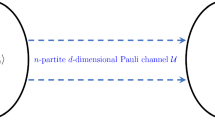Abstract
Entanglement is a global characteristic unique to quantum states that depends on quantum coherence and may allow one to carry out communications and information processing tasks that are either impossible or less efficient using classical states. Because environmental noise, even when entirely local in spatial extent, can fully destroy entanglement in finite time, an effect referred to as “entanglement sudden death” (ESD), it may threaten quantum information processing tasks. Although it may be possible to “distill” entanglement from a collection of noise-affected systems under appropriate circumstances, once entanglement has been completely lost no amount of distillation can recover it. It is therefore extremely important to avoid its complete destruction in times comparable to those of information processing tasks. Here, the effect of local noise on a class of entangled states used in entanglement-based quantum key distribution is considered and the threat ESD might pose to it is assessed.
Similar content being viewed by others
References
Almeida MP, de Melo F, Hor-Myell M, Salles A, Walborn SP, Souto Ribero PH, Davidovich L (2007) Environment-induced sudden death of entanglement. Science 316:579
Ann K, Jaeger G (2007) Local-dephasing-induced entanglement sudden death in two-component finite-dimensional systems. Phys Rev A 76:044101
Ann K, Jaeger G (2008) Entanglement sudden death in qubit-qutrit systems. Phys Lett A 372:579
Ann K, Jaeger G (2009) Finite-time destruction of entanglement and non-locality by environmental influences. Found Phys 39:790
Bennett CH, Popescu S, Rohrlich D, Smolin JA, Thapliyal AV (2001) Exact and Asymptotic Measures of multipartite pure state entanglement. Phys Rev A 63:012307
Caves CM, Milburn GJ (2000) Qutrit entanglement. Opt Commun 179:439
Ekert AK (1992) Quantum cryptography based on Bell’s theorem. Phys Rev Lett 67:661
Gisin N, Ribordy G, Tittel W, Zbinden H (2002) Quantum cryptography. Rev Mod Phys 74:145
Jaeger G (2003) Method and apparatus for creating at least one qubit in a quantum computing device. US Patent No. 6,633,053
Jaeger G (2004) Bell gems: the Bell basis generalized. Phys Lett A 329:425
Jaeger G, Sergienko AV (2006) Entangled states in quantum key distribution. AIP Conf Proc 810:161
Jaeger G (2007) Quantum information: an overview (chapter 10). Springer, Heidelberg
Jaeger G, Ann K (2008) Generic tripartite Bell nonlocality sudden death under local phase noise. Phys Lett A 372:6853
Kraus K (1983) States, effects, and operations. Springer, Berlin
Palma GM, Suominen K-A, Ekert AK (1996) Quantum computers and dissipation. Proc R Soc Lond A 452:567
Salles A, de Melo F, Almeida MP, Hor-Meyll M, Walborn SP, Souto Ribeiro PH, Davidovich L (2008) Experimental investigation of the dynamics of entanglement: Sudden death, complementarity, and continuous monitoring of the environment. Phys Rev A 78:022322
Walton ZD, Abouraddy AF, Sergienko AV, Saleh BEA, Teich MC (2003) Decoherence-free subspaces in quantum key distribution. Phys Rev Lett 91:087901
Werner RF (1989) Quantum states with Einstein–Podolsky–Rosen correlations admitting a hidden-variable model. Phys Rev A 40:4277
Werner RF, Wolf MM (2001) Bell inequalities and entanglement. Quantum Inf Comput 1(3):1
Wootters WK (1998) Entanglement of formation of an arbitrary state of two qubits. Phys Rev Lett 80:2245–2248
Yu T, Eberly JH (2004) Finite-Time disentanglement via spontaneous emission. Phys Rev Lett 93:140404
Yu T, Eberly JH (2006) Quantum open system theory: bipartite aspects. Phys Rev Lett 97:140403
Yu T, Eberly JH (2007) Evolution from entanglement to decoherence. Quantum Inf Comp 7:459
Acknowledgments
This research was supported by the DARPA QUINESS program through U.S. Army Research Office Award No. W31P4Q-12-1-0015.
Author information
Authors and Affiliations
Corresponding author
Rights and permissions
About this article
Cite this article
Jaeger, G.S., Sergienko, A.V. Entanglement sudden death: a threat to advanced quantum key distribution?. Nat Comput 13, 459–467 (2014). https://doi.org/10.1007/s11047-014-9452-7
Published:
Issue Date:
DOI: https://doi.org/10.1007/s11047-014-9452-7




